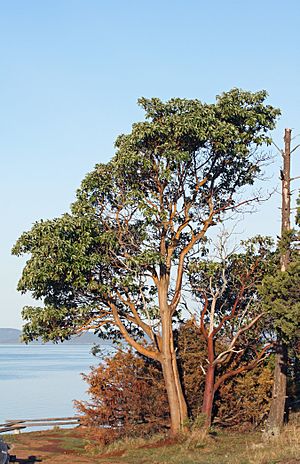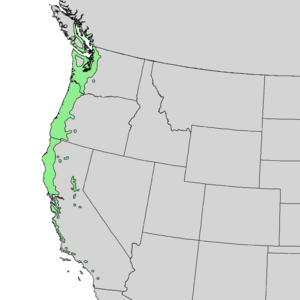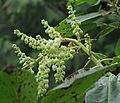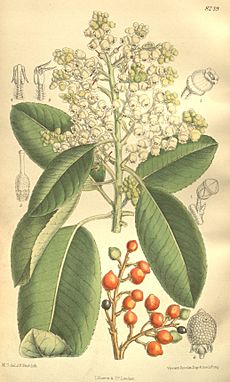Pacific madrone facts for kids
Quick facts for kids Pacific madrone |
|
|---|---|
 |
|
| Conservation status | |
| Scientific classification | |
| Genus: |
Arbutus
|
| Species: |
menziesii
|
 |
|
| Natural range of Arbutus menziesii | |
| Synonyms | |
|
|
The Pacific madrone (also called madrona) is a beautiful tree. Its scientific name is Arbutus menziesii. It belongs to the Ericaceae family, which also includes blueberries and rhododendrons. You can find this tree growing along the western coast of North America. It stretches from British Columbia in Canada all the way down to California in the United States.
Contents
Common Names for the Pacific Madrone
This tree has many different names! People often call it madrona, madrone, madroño, madroña, or bearberry. Sometimes, it's even called "strawberry tree." But don't get confused, it's not related to the actual strawberry fruit.
In the United States, people south of the Siskiyou Mountains (in southern Oregon and northern California) usually say "madrone." Those living north of the Siskiyous often say "madrona." In British Columbia, people simply call it "arbutus."
The Concow tribe, a Native American group, has their own names for the tree. They call it dis-tā'-tsi or kou-wät′-chu. The tree's scientific name, menziesii, honors a Scottish naturalist named Archibald Menzies. He first noticed this tree during George Vancouver's famous exploration voyage.
What Does the Pacific Madrone Look Like?
The Pacific madrone is an evergreen tree. This means it keeps its leaves all year round. It has amazing orange-red bark that peels off in thin sheets when the tree gets older. This peeling bark reveals a smooth, shiny, greenish-silver layer underneath.
Flowers and Berries
In the spring, the madrone grows clusters of small, white, bell-shaped flowers. In the autumn, these flowers turn into bright red berries. These berries are special because they dry up and have tiny hooks. These hooks help the berries stick to animals, which then carry them to new places. This helps the tree spread its seeds.
Size and Leaves
Most madrones are about 10 to 25 meters (33 to 82 feet) tall. But in perfect conditions, some can grow up to 30 meters (98 feet) tall! Their trunks can also become very thick, reaching 1.5 to 2.4 meters (5 to 8 feet) across, similar to an oak tree.
The leaves are thick and waxy. They are oval-shaped, about 7 to 15 centimeters (3 to 6 inches) long and 4 to 8 centimeters (2 to 3 inches) wide. They grow in a spiral pattern around the branches. The top of the leaves is glossy dark green, and the bottom is a lighter, grayish-green. The edges of the leaves are smooth. While the leaves are evergreen, sometimes in colder, wet areas, they might turn brown or black from a fungus. This stain stays until the leaves naturally fall off.
Where the Pacific Madrone Lives
Madrones grow naturally along the western coast of North America. You can find them from British Columbia in Canada, especially on Vancouver Island and the Gulf Islands, all the way down to California.
They are most common in places like Puget Sound, the Oregon Coast Range, and the California Coast Ranges. You can also see them scattered on the western slopes of the Sierra Nevada and Cascade mountain ranges. South of Santa Barbara County, they are rare. There are only a few isolated groups as far south as Palomar Mountain in California. While some people think they might grow in Baja California, Mexico, there's no clear proof of that. However, other types of Arbutus trees do grow there.
How to Grow a Pacific Madrone
Growing a Pacific madrone can be tricky! It's best to plant a seedling in its permanent spot when it's still very small. If a madrone is more than 30 centimeters (1 foot) tall, it's much harder to move it successfully.
The best place to plant a madrone is a sunny spot, like a south or west-facing hillside. The soil needs to drain water well and should not have too much lime. Once the tree is established in its natural area, it usually doesn't need extra water or fertilizer. Giving it too much water or nitrogen fertilizer can make it grow faster, but it also makes the tree more likely to get sick.
This plant is so special that it has received the Royal Horticultural Society's Award of Garden Merit.
Uses of the Pacific Madrone
The Pacific madrone has been useful to both people and animals for a long time.
Traditional Uses by Native Americans
Native American people ate the madrone berries. They ate them raw or cooked. The berries have a lot of tannin, which can make your mouth feel dry. So, people often chewed them or made them into a cider. Eating too many berries could cause stomach cramps.
Native Americans also used the berries to make necklaces and other decorations. They even used them as bait for fishing! The bark and leaves of the madrone were used as medicine. People made tea from the bark to help with stomach aches, cramps, skin problems, and sore throats.
Wildlife and Wood Uses
Many animals and birds love to eat the madrone berries. These include American robins, cedar waxwings, band-tailed pigeons, varied thrushes, quail, mule deer, raccoons, ring-tailed cats, and bears. Mule deer also eat the young shoots of the tree after a fire.
The flowers produce nectar, which bees can turn into honey. Madrone trees are also important places for birds to build their nests.
The wood of the madrone is strong and has a beautiful warm color when finished. It's becoming more popular for flooring, especially in the Pacific Northwest. You can also make attractive veneer from it. However, large pieces of madrone wood can twist and warp a lot when they dry. Because of this, they are not used much for big lumber projects. Madrone wood is excellent for firewood because it is very hard and dense. It burns for a long time and produces a lot of heat, even more than oak wood.
Why the Pacific Madrone is Declining
Even though the Pacific madrone can handle dry weather and grows fairly quickly, its numbers are going down in most places where it lives.
Impact of Fire Control
One big reason for this decline is how we control fires. Naturally, madrones depend on occasional wildfires. These fires help clear out other trees, like Douglas firs, that grow taller and block the madrone's sunlight. Mature madrones can survive fires. They also grow back faster after a fire than Douglas firs. Madrones also produce many seeds that sprout after a fire, helping new trees grow. When fires are prevented, other trees can outcompete the madrone.
Development and Disease
More and more buildings and towns are being built in the madrone's natural habitat. This development also causes the number of mature madrone trees to drop. These trees are very sensitive to changes in the ground level or how water drains near their roots. If these things are changed, the tree can get sick or die.
For a long time, people on the west coast didn't realize how sensitive these trees were. But since the 1970s, many local governments have put strict rules in place. These rules help protect madrone trees when there are building projects nearby. The madrone tree can also be affected by a disease called sudden oak death. This disease is caused by a type of water mold.
The Largest Pacific Madrone Tree
In the summer of 2016, during the Soberanes Fire, the largest known Pacific madrone tree was burned. It might have been killed by the fire. This giant tree was 38 meters (125 feet) tall and more than 7.6 meters (25 feet) around its trunk. It was listed on the American Forests National Big Tree list, which keeps track of the biggest trees of each species in the United States. This amazing tree was located in the Joshua Creek Canyon Ecological Reserve, along the Big Sur Coast of California. Sadly, the fire that burned it was caused by an illegal campfire.
See also
 In Spanish: Madroño del Pacífico para niños
In Spanish: Madroño del Pacífico para niños















